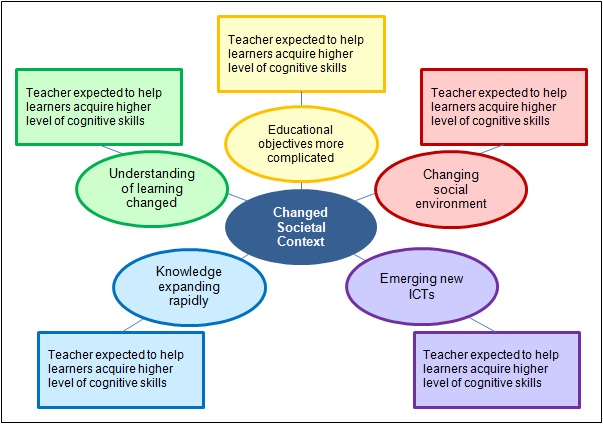Educational Context
2. Implications for Education
You would have reflected on how the education sector will cater to the demands of the global society today. What would be the implications of these demands on the curricular content and transaction? Let us discuss this in this section.
Read Chapter 1-Dynamics of Technology in Education, Section- Implications for Education (Pages: 6-8).of the following book
Wadi D. Haddad and Alexandra Draxler (2002) Technologies for Education- Potential, Parameters and Prospects.
http://www.ictinedtoolkit.org/usere/library/tech_for_ed_chapters/01.pdf
The four dramatic challenges pose serious questions for:
a. Planning education and training.
b. Rethinking in the way education is perceived and managed.
c. Prioritising scale, size, and speed of education development.
These leave education development with six far-reaching implications:
a. Holistic education structureb. Focus on learning acquisition and outcomesThe workforce of the future will need:
i. A whole spectrum of knowledge and skills to deal with technology and the globalisation of knowledge and
ii. The need to be agile and flexible, to adjust to continuous changes, both economic and social.
This means that countries must embrace a holistic approach to education, investing concurrently in the whole pyramid of basic education, secondary education, skill training, and tertiary education. Since each level in the knowledge structure has its own importance, and one cannot be traded for another, the question is not whether to provide it, but how, how fast, and through what mechanisms.
The objectives of education such as teaching how to learn, problem solving, and synthesising the old with the new, are indispensable now.
To achieve these results education must be,
i. Engaging, in the sense that the student is involved in the learning process and not viewed simply as a "receptacle" for knowledge, and
ii. Authentic, in the sense that what the student is learning has meaning to him or her as an individual, a member of society, and a worker in the marketplace.
c. Education for everyone
Modern economic, social, political, and technological requirements demand that all members of society have a minimum level of basic education.
People without the ability to acquire essential knowledge and skills will live precariously, and society will be deprived of their contributions. Similarly, selective opportunities for higher levels of education must reflect equity concerns so that in times of rapid educational change, historical disparities by gender, region, or social grouping are not propagated.
d. Education anytime
The need for continuous access to information and knowledge makes learning life-long and the traditionally neat distinction between learning and work unreal.
Education thus becomes a continuum, with no marked beginning and end, which provides opportunities for life-long learning to help individuals, families, workplaces, and communities to adapt to economic and societal changes, and to keep the door open to those who have dropped out along the way. Learning throughout life is one of the keys to the twenty-first century.
e. Education anywhere
Life-long learning and training for the workplace cannot be confined to the traditional classroom. It is unrealistic and unaffordable to continue to ask learners to come to a designated place every time they have to engage in learning. To cope with the diversity, complexity, and changing demands for education services, delivery must extend beyond the face to face institutional modality to include distance education, enrichment mass media, and non-formal settings.
f. Teacher empowerment
Teaching is one of the most challenging and crucial professions in the world.
i. Teachers are critical in facilitating learning and in making it more efficient and effective, and they will continue to be in the future.
ii. They hold children's hands through the hard transition from the warmth of the home to the unfamiliar environment of the school.
iii. They help to decipher those funny-looking shapes called letters.
iv. They bring life to formula and equations; they prepare the stage for learners to shout, "eureka"; they bring the world into the classroom and the classroom into the world.
v. They try to make sense of the directives of central education authorities and implement reforms formulated by "experts" and parachuted to them.
Teachers are underpaid and ill-prepared, yet accountable for successful teaching. They are expected to understand and address the needs of students, parents, administrators, society, the economy, the past, the present, and the future.
Figure 1.4 shows how teachers are expected to deal with the different challenges posed by society on the educational system and the classroom context.

Figure 1.4 Challenges and implications: teachers' role
Licensed under the Creative Commons Attribution 3.0 License